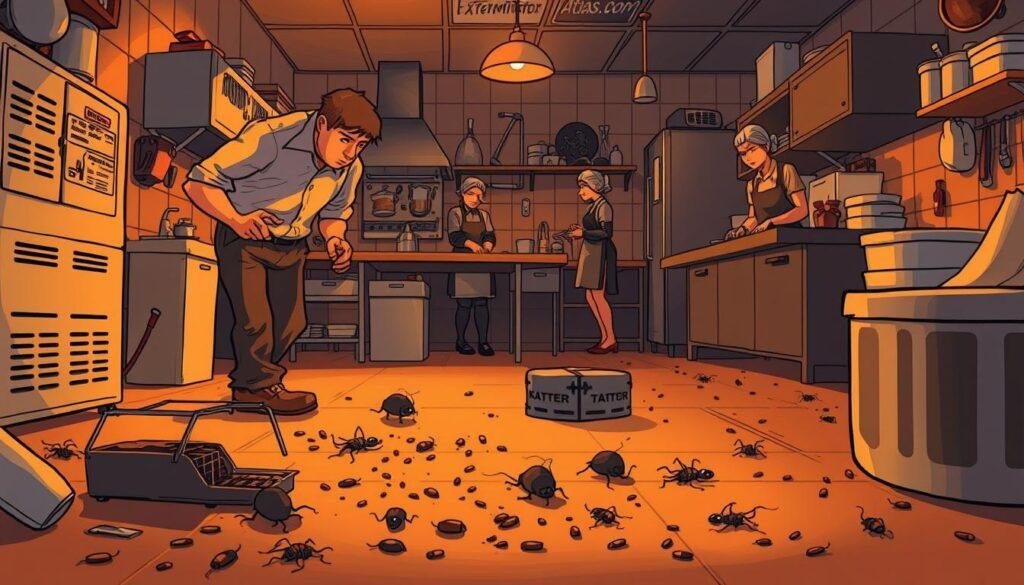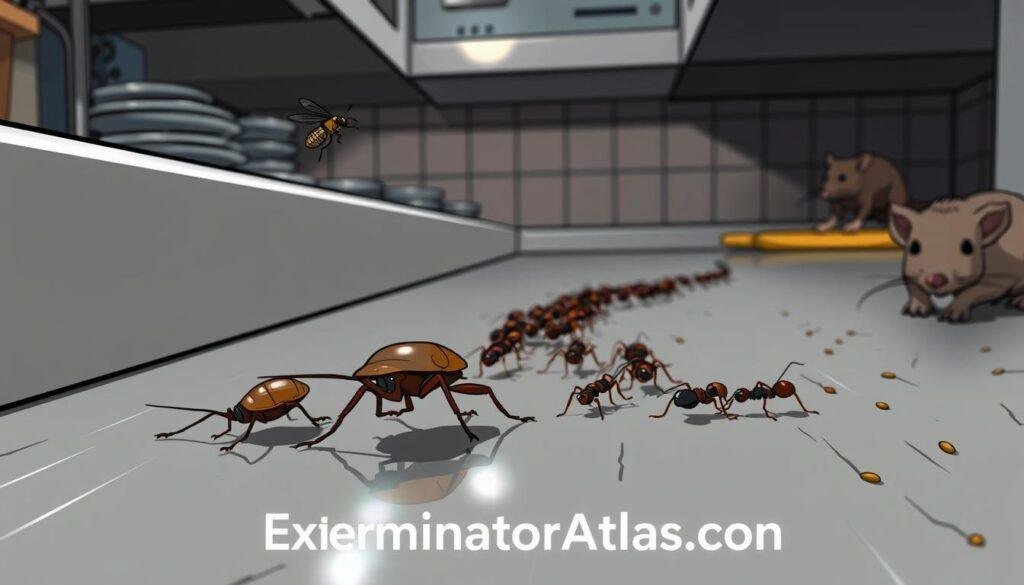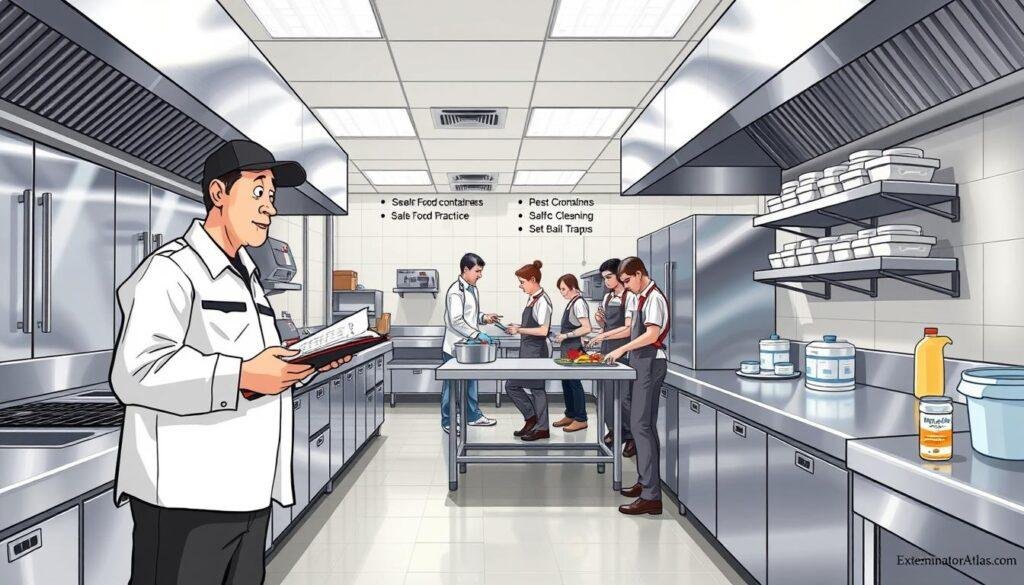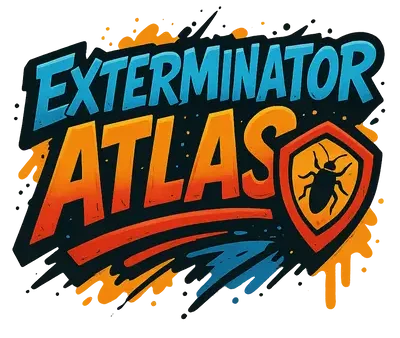Pest Control for Restaurants and Food Businesses: Best Practices

Restaurant pest control is essential for food business owners across the U.S. Did you know nearly 85% of restaurants reported a pest problem in a single year? This highlights how critical pest management is—not only for health and safety, but also for maintaining a clean reputation. After all, your brand matters just as much as the food you serve.
Pests don’t care if you make simple burgers or fine cuisine. Effective pest control practices help prevent infestations, protect staff and customers, ensure compliance with food safety regulations, and safeguard your revenue in a competitive industry.
Key Takeaways
- Restaurants must take proactive measures to prevent pests from compromising health and safety standards.
- Effective commercial kitchen pest management is crucial for maintaining a restaurant's reputation and revenue.
- Professional restaurant pest removal services can offer specialized support tailored to your business's specific needs.
- Adherence to health codes and regulations is non-negotiable for operating a successful food service establishment.
- Understanding the types of pests and their consequences is vital in developing a comprehensive pest control program.
- Understanding the Importance of Pest Control in Restaurants
- Common Pests in the Restaurant Industry
- Preventive Measures for Restaurant Pest Management
- Developing an Effective Pest Control Program
- Restaurant Pest Control USA: Adapting Strategies for Different States
- Commercial Kitchen Pest Management Best Practices
- Food Service Pest Extermination Techniques
- Restaurant Rodent Control Services: What to Look For
- Professional Restaurant Pest Removal Solutions
- Commercial Insect Control for Restaurants: Key Considerations
- Staying Up-to-Date with Pest Control Regulations and Trends
- FAQ
Understanding the Importance of Pest Control in Restaurants
Running a successful restaurant means keeping pests under control. It's key to focus on food service pest extermination and restaurant rodent control services. Doing so keeps your place healthy and safe. It also protects your restaurant's good name and money.

Not handling pests well can lead to big problems, like health risks and fewer customers. We're about to look at three main reasons why good pest control is so important for any restaurant.
Impact on Health and Safety
As a restaurant owner, your biggest job is to keep everyone healthy and safe. Pests can spread many illnesses. They can get into food, touch surfaces, or be in the air. Using food service pest extermination stops these diseases. This protects your customers and staff.
Risks to Reputation and Revenue
Pests can ruin your restaurant's image. With online reviews and social media, just one pest can cause bad press. This turns away customers and hurts your income. Using restaurant rodent control services keeps your place clean. This makes customers trust you more and come back.
Compliance with Health Codes and Regulations
You must follow local health codes and rules. There are strict laws about pests in restaurants. If you don't, you could get fined, face legal trouble, or have to close. Good pest control shows you care about quality and safety. Inspectors and customers take those things very seriously.
Common Pests in the Restaurant Industry
In the busy world of food service, keeping a clean space is key to your success. Knowing the common pests in restaurants can really help in making a good plan for commercial insect control for restaurants.

- Rodents: These pests are known for hiding and growing in number fast. They are a big health risk because they carry diseases.
- Cockroaches: The German cockroach, especially, is hard to manage because they reproduce quickly and can spread sickness.
- Flies: They hover around open food, and pose a health threat by carrying diseases.
- Stored Product Pests: Like weevils and beetles, they can come with deliveries and spoil your food stock fast.
Spotting these pests early and taking action with commercial insect control for restaurants is crucial. Quick spotting and acting can prevent health issues, loss of customers' trust, and failing health inspections.
Preventive Measures for Restaurant Pest Management
Keeping your restaurant clean and safe starts with good pest control. By taking steps early, you can meet health rules and keep your brand's good name. Let's look at important steps like storing food right, cleaning often, and making your building secure.
Every restaurant's first line of defense against pests includes comprehensive storage, cleaning, and structural maintenance.
Proper food storage techniques are key in restaurant pest control USA. Keeping food up off the floor and in sealed containers cuts down on pest attraction. Checking storage spots for pests regularly helps stop problems early.
Keeping things clean is a must in restaurants. Regular cleaning and maintenance get rid of possible pest food sources. This means cleaning floors and surfaces every day and getting rid of trash in sealed bins. Sanitizing areas where food is dealt with keeps pests away.
To strengthen food service pest extermination, it's vital to secure your building. Check for and seal up any cracks or gaps. This stops new pests from coming in and makes it hard for infestations to start.

- Routine inspection and maintenance of structural integrity.
- Employee training on hygiene practices and pest detection.
- Partnerships with professional exterminators for regular assessments.
Putting these steps into action builds a strong defense against pests. It shows your dedication to a safe, clean eating place. Paying attention to these points makes your pest control plan much better.
Developing an Effective Pest Control Program
As a restaurant owner, making sure your place is free from pests is essential. It keeps your customers safe and protects your restaurant's name. Starting with a detailed check-up helps in making a good commercial kitchen pest management plan.
To assess effectively, identify present and possible pest problems. Look at where food is handled, made, and eaten. These spots are most likely to have pests. Planning means choosing how often to control pests, picking the best methods, and scheduling treatments to not disturb your work.
Choosing the Right Pest Control Partners
Finding the perfect pest control partner is key to your restaurant's wellbeing. You want someone with a good history and all the right papers. They should offer a plan that fits your needs well. This plan should include checking up often, preventing pests before they appear, and acting fast if pests are found.
With the right parts in your plan, you can manage pests now and stop them in the future. This makes sure your restaurant is clean and safe for everyone who works and eats there.
Restaurant Pest Control USA: Adapting Strategies for Different States
For restaurant owners, it's vital to tweak your pest control plan based on your state's climate and rules. Every area has its own pest control battles because of its unique weather and legal demands. This means you need special ways to keep pests out of your food areas.
Different climates make different pests pop up. Warmer places might have pests all year, but colder spots see them more in some seasons.
- It's smart to know when and what pests are common in your area. This helps you fight them better.
- Learn the local health rules too. They change a lot and affect how you can control pests.
- Use pest control methods that work best for your state's weather and pest types for effective results.
Being informed and flexible helps keep your food place safe and clean for everyone. Plus, you'll meet all the local legal standards.
Commercial Kitchen Pest Management Best Practices
Keeping your kitchen clean is fundamental for pest control in commercial settings. A spotless kitchen acts as a barrier to pests. To stay pest-free, regularly check and monitor your kitchen.
Here's a guide to making these methods work for you.
Focus on Hygiene and Sanitation
Every area related to food - storage, preparation, or serving - must follow strict cleaning rules. Quick actions like wiping spills, clearing counters of crumbs, and frequently taking out sealed trash greatly lower pest attraction chances. How well you keep the area clean directly affects your battle against pests in a professional restaurant pest removal context.
Regular Inspection and Monitoring
A steady schedule for inspections is key in spotting pests early. Use smart traps and trackers to monitor high-risk areas. Catching and fixing problems early helps you keep up with health standards and avoid infestations.
- Conduct weekly audits of kitchen areas to check for signs of pests.
- Implement cleaning audits to ensure compliance with sanitation protocols.
- Use pest monitoring tools that help track and identify any early signs of pest presence.
By making these strategies a regular part of your routine, you not only strengthen your commercial kitchen pest management efforts but also boost your restaurant's safety and quality. Being proactive is the best way to keep your kitchen clean, safe, and free from pests.
Food Service Pest Extermination Techniques
Keeping pests out is key for a food place's good name and smooth running. When looking at ways to kill pests, it's good to know the difference between using traps or chemicals. Also, using Integrated Pest Management (IPM) helps make restaurant pest control USA safer and more effective.
Physical vs. Chemical Controls
To choose between traps and chemicals, consider the pest problem and where your food service is. Traps and electric zappers are best for areas where customers can see, to keep things looking clean. But, for big problems or pests in hard-to-get spots, chemicals might be needed. Just be careful to keep food safe.
Implementing Integrated Pest Management (IPM)
IPM focuses on preventing pests, keeping a close watch, and using chemicals wisely. By using IPM, you reduce the need for harsh chemicals and work on keeping pests away for good. Main steps include:
- Changing the environment to stop pests
- Using safe traps and baits
- Getting help from natural enemies of pests
After getting rid of pests, cleaning and sanitizing all areas that touch food is a must. This keeps customers and staff safe.
Using these methods keeps your restaurant clean and meets health rules. Keeping your restaurant pest control USA plans up to date makes your place safe and inviting for everyone.
Restaurant Rodent Control Services: What to Look For
Choosing the right restaurant rodent control services is key to a clean restaurant. Make sure you pick a service that offers effective and professional restaurant pest removal.
Choosing a competent rodent control service is not just about immediate eradication but about setting the foundation for a pest-free environment in the long run.
Look closely at a provider's history before making a choice. It's important they have the right certifications and are known for their detailed and flexible pest control methods.
A tailored rodent control plan is critical for good results. Consider these important points:
- Inspection thoroughness – how well the service checks your place, finds where rodents get in, and figures out how many there are.
- Approach to eradication – they should use methods that are okay and safe for restaurants, like traps or baits.
- Preventative measures – include plans to stop future infestations to protect your business over time.
Restaurant rodent control services should offer more than a quick fix. They need to work closely with you, knowing how to get rid of pests and keep them away.
Professional Restaurant Pest Removal Solutions
Running a restaurant means keeping it free of pests to protect health and satisfy customers. Professional pest removal services give quick fixes and prevention tactics. Let's look at why it's smart to hire experts and how they keep things safe.
Advantages of Hiring Experts
Hiring pros for commercial kitchen pest management brings big benefits. They know how to spot and stop various pests in kitchens, like mice or bugs. They use special ways to get rid of these pests for good.
- Specialized Equipment: They have advanced gear, better than DIY options.
- Regulatory Compliance: They follow health rules to keep your spot out of trouble.
- Customized Strategies: They plan based on your kitchen's layout and needs for targeted pest control.
Ensuring Safe Application of Pest Control Measures
Choosing pros for professional restaurant pest removal also means they do things safely. They know how to apply treatments without putting your food at risk. This is key for keeping your place clean.
- Use of Safe Chemicals: They use chemicals approved by the EPA, safe for kitchens.
- Minimizing Disruption: They can work when your business is closed to avoid bothering your work.
- Continuous Monitoring: They keep an eye on things after the first treatment to guard against pests coming back.
With professional pest control, you get a clean kitchen and stress relief. Your business and customers stay safe from harm. This is why it's a smart move for restaurant owners.
Commercial Insect Control for Restaurants: Key Considerations
Keeping pests out is vital for a clean and rule-following kitchen in the food world. Making sure your place fights off pests keeps health standards high and saves your restaurant's image. Let's look at some key ways for commercial insect control for restaurants.
To start, know the bug-friendly spots in your restaurant. Places like storerooms, garbage areas, and wet spots draw pests.
Identifying Vulnerable Areas in Your Establishment
- Kitchens and bar areas where food and moisture are abundant.
- Storage rooms where boxes and equipment can provide hiding spots.
- Trash disposal areas that can attract pests from outside.
Specialized Insect Control Techniques
Different food service pest extermination methods exist, depending on your restaurant's issues. Professionals use several advanced techniques:
- Targeted treatments that focus on known insect pathways and entry points.
- Application of insect growth regulators to disrupt the pests’ lifecycle.
- Strategic placement of bait stations to effectively control insect populations.
Getting help from expert exterminators means your place is guarded by the best food service pest extermination methods. These pros have the right tools and knowledge for customized solutions. This keeps your restaurant safe and follows health rules.
In the end, acting early and carefully with commercial insect control for restaurants is key. Spotting troubles and using specific tactics help keep your dining area clean and pest-free.
Staying Up-to-Date with Pest Control Regulations and Trends
In the fast-changing world of restaurant pest control USA, keeping up with new rules and trends is crucial. Your business's health and success depend on it. As a restaurant owner, you must stay alert to changes in laws at all levels. These changes shape how you deal with pests. It's not just about following rules; it's about being a leader in food safety and cleanliness.
The field of commercial kitchen pest management keeps growing thanks to new technologies and methods. Things like eco-friendly products or strategies that reduce chemical use are always emerging. Keeping current lets you use the best and safest pest solutions. These protect your customers and the planet.
Pests keep evolving because of changes in weather, cities, and global trade. So your approach to fighting pests must evolve too. Stay informed on these changes. It helps you update your pest control plans. Making sure your restaurant is clean and safe boosts your reputation. And in this business, your reputation is key.
FAQ
Why is pest control important for restaurants and food service establishments?
What are the most common pests found in the restaurant industry?
What are some effective preventive measures for restaurant pest management?
How do I develop a comprehensive pest control program for my restaurant?
Does pest control strategy vary by state within the USA?
What are some best practices for commercial kitchen pest management?
What are the primary techniques used in food service pest extermination?
What should I look for when selecting a restaurant rodent control service?
What are the advantages of hiring professional pest removal experts for my restaurant?
What considerations should I keep in mind for commercial insect control in my restaurant?
How important is it to stay current with pest control regulations and trends?
Whether you’re tackling a single rogue ant or battling a full-scale termite invasion, our guide has you covered. Save Pest Control for Restaurants and Food Businesses: Best Practices to your bookmarks and visit often—we refresh tips, treatment methods, and product reviews throughout 2025 so you can keep every pest problem under control the moment it appears.

Leave a Reply